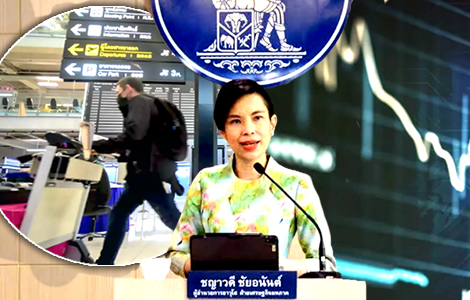Foreign tourism is falling, signalling a precarious future. Manufacturing is slumping and the services sector has stumbled. Analysts warn of challenges ahead, while the government talks of intervention, the Bank of Thailand emphasises stability.
The Bank of Thailand, this week, held Thai borrowing rates at 2.5% with indications that it may hold the rate throughout 2024 until 2025 as it reported a pickup in GDP growth in the final quarter of the year even though the economy remains fragile with reduced manufacturing output and falling foreign tourism numbers which have led the bank to downgrade the 2023 projected growth level to 2.4%.

In a widely anticipated move, the Bank of Thailand’s Monetary Policy Committee announced on Wednesday that it would maintain its key interest rate at 2.50%, signalling the end of a year-long tightening cycle. The decision comes against the backdrop of a sluggish economy and inflation below the target.
The top Bank of Thailand panel voted to keep the one-day repurchase rate steady at 2.50%, marking the highest level in a decade. This comes after a series of rate hikes totalling 200 basis points since August of the previous year, aimed at curbing inflation.
Analysts surveyed by Reuters predicted the central bank to hold rates given the economy’s fragility and concerns over loan quality in the banking system
All 28 economists surveyed in a Reuters poll correctly predicted that the Bank of Thailand would maintain the rate, with median forecasts suggesting no policy changes until at least July 2025.
This offers already strained business operators and employers some certainty and respite as Thailand’s interest rate levels are well below world norms.
It also comes amid growing concerns about a potential rise in non-performing loans in the banking sector currently at 2.7% with Stage 2, or deteriorated loan quality loans, standing at 5.85%.
Thai economy is externally robust but imbalanced with private sector debt problems in the short term and demographics in the medium term
The Bank of Thailand presentation was a mixed bag of data and projections for the country’s economic performance.
It predicted robust gross domestic product (GDP) growth of 3.7% in the final quarter of this year although it cut the full year’s GDP growth projection to 2.4%, down from last year when it came in at 2.6%.
Reports for the last 3 months show exports picking up but manufacturing output continuing to decline
This is supported by conflicting signals as exports slowly begin to recover but from a very low base in 2022 while the country’s production levels continue to fall with the Manufacturing Production Index (MPI) falling by 4.29% year-on-year in October to 89.4 points.
This last quarter projection may also be misleading and is attributed to the low-base effect, driven by ongoing recovery efforts fueled by private consumption and a revival in tourism.
Chayawadee Chai-anant, Assistant Governor of the Corporate Relations Group at the Bank of Thailand, emphasised that the improved growth outlook for the last quarter is a result of the low-base effect when compared year-on-year. This positive projection is part of the broader economic recovery led by domestic demand, with private consumption and investment playing pivotal roles.
The National Economic and Social Development Council (NESDC) reported third-quarter GDP growth of 1.5%, a worrying fall from the 1.8% recorded in the previous quarter.
Disturbing signs in the latest data with reduced service sector activity and a falloff in foreign tourism numbers, key engines of economic growth
The Bank of Thailand’s October 2023 report on ‘Economic and Monetary Conditions’ underscored an ongoing recovery, fueled by domestic demand, but noted a slowdown in the service sector due to a decline in both domestic and foreign tourist numbers.
Tourism, a critical sector for Thailand, has faced challenges reflected in the economic report.
The decline in foreign arrivals, particularly from Russia, coupled with the postponement of trips by Malaysian tourists, contributed to a 1.4% month-on-month drop in October. However, arrivals from China, the United Kingdom and European Union member states, notably Germany, increased.
Tourist expenditure softened due to fewer arrivals and a lower occupancy rate, according to Chayawadee Chai-anant.
For the year, offshore tourists totalled 22.2 million, with the central bank forecasting 28.3 million by the end of the year although some analysts now suggest a figure of 27.5 million.
Fall in foreign tourists already impacting spending
Private consumption indicators showed positive signs, rising by 7.3% year-on-year and 1.7% month-on-month in most categories. However, services, particularly in the hotel and restaurant sector, experienced a decline in spending due to fewer domestic and foreign tourists.
Merchandise exports, excluding gold, saw a decline of 1.4% from the previous month.
The depreciation of the baht against the US dollar in October was attributed to speculation about a more aggressive stance by the United States Federal Reserve on rate hikes and global uncertainties arising from the conflict in the Middle East.
Despite this, the baht has recently rebounded against the dollar as markets anticipate a stable US rate due to softer US growth.
Bank of Thailand and the government continue to have different priorities with the economic data unfortunately giving both ammunition to argue
The Bank of Thailand’s decision to maintain the key rate reflects a strategic response to the complex economic landscape, with an eye on global uncertainties.
The optimistic GDP growth projection for the final quarter indicates resilience in the face of challenges, particularly in the crucial tourism sector.
As Thailand continues on its path to economic recovery, the central bank’s role in navigating uncertainties and maintaining stability remains pivotal.
The economic situation and data come with the government of Prime Minister Srettha Thavisin pushing for stimulus intervention while the Bank of Thailand is pushing back and urging that the priority right now must be preserving the country’s financial stability while addressing long-term chronic problems such as household debt which the cabinet addressed this week.
Join the Thai News forum, follow Thai Examiner on Facebook here
Receive all our stories as they come out on Telegram here
Follow Thai Examiner here
Further reading:
Srettha’s crisis is not just an economic one, it is a ‘3D debt crisis’ that is strangling GDP growth
Zombie Thai firms holding back economic growth as they struggle just to pay interest on bank debt
Incoherent government economic policy clashes with Bank of Thailand’s efforts to rein in debt
Economy is in troubled waters with fears for both exports and foreign tourism as 2023 winds down
Thailand faces an economic future of low growth despite Srettha’s plans because of a darker world
Another dip for the baht or are economic danger signals flashing for both Thailand and the world?
Police chief confirms 2 dead with reports of at least one more fatality in Bangkok mass shooting
Bank of Thailand boss appears critical of the new government’s policy initiatives on the economy
Concerns over household debt rising as banks report marginally lower non-performing loans
Thailand preparing for a soft landing as ‘cracks’ open up in the Chinese economy says bank chief
Economic danger signals emerging as politicians wrangle over who will form the next government
Potential hazard lights flashing as kingdom’s auto loans spiral into default with sky-high borrowing


















